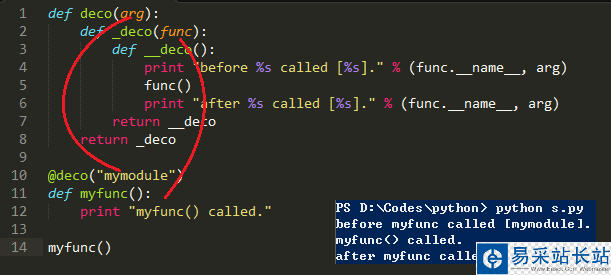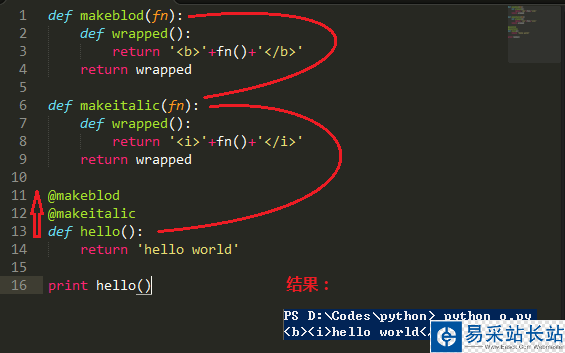本文实例讲述了Python装饰器模式定义与用法。分享给大家供大家参考,具体如下:
装饰器模式定义:动态地给一个对象添加一些额外的职责。
在Python中Decorator mode可以按照像其它编程语言如C++, Java等的样子来实现,但是Python在应用装饰概念方面的能力上远不止于此,Python提供了一个语法和一个编程特性来加强这方面的功能。
首先需要了解一下Python中闭包的概念:如果在一个内部函数里,对在外部作用域(但不是在全局作用域)的变量进行引用,那么内部函数就被认为是闭包(closure)。

def makeblod(fn): def wrapped(): return '<b>'+fn()+'</b>' return wrappeddef makeitalic(fn): def wrapped(): return '<i>'+fn()+'</i>' return wrapped@makeblod@makeitalicdef hello(): return 'hello world'print hello()
运行结果:
<b><i>hello world</i></b>

def deco(arg): def _deco(func): def __deco(): print "before %s called [%s]." % (func.__name__, arg) func() print "after %s called [%s]." % (func.__name__, arg) return __deco return _deco@deco("mymodule")def myfunc(): print "myfunc() called."myfunc()运行结果:
before myfunc called [mymodule].
myfunc() called.
after myfunc called [mymodule].
关于闭包学习可参考:https://www.jb51.net/article/54498.htm
更多关于Python相关内容可查看本站专题:《Python数据结构与算法教程》、《Python Socket编程技巧总结》、《Python函数使用技巧总结》、《Python字符串操作技巧汇总》及《Python入门与进阶经典教程》
希望本文所述对大家Python程序设计有所帮助。
新闻热点
疑难解答